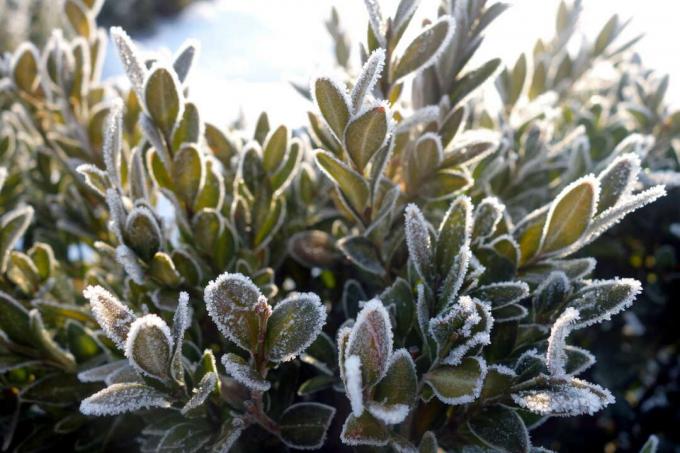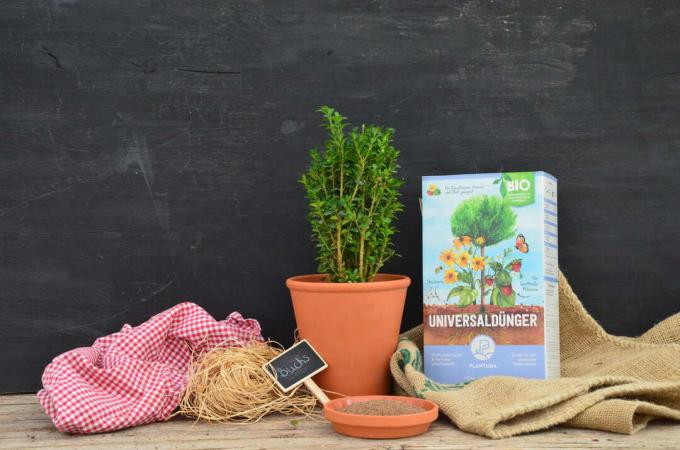Unsuitable environmental conditions can severely affect the beloved boxwood. We show how frost damage, sunburn and other damage can be recognized.

the boxwood (boxy) finds a place as an ornamental shrub in almost every garden. But more and more often we hear about creepy diseases that affect the beloved evergreen shrub (find out about common ones here Pests on boxwood and effective countermeasures). As if the pests and fungal diseases weren't enough, the Buchs is often shaken by unsuitable environmental conditions. The classic here is different damage caused by the effects of frost on the leaf and also on the root. But too much sunlight can also cause problems for the boxwood and lead to sunburn. After salt spreading in winter, stress can sometimes arise with boxwood specimens that are close by. All of this damage can be traced back to so-called abiotic causes of damage. They are not caused by pathogens such as pests or fungi, but come about in a different way. In the following, we will take a closer look at this abiotic damage to boxwood.
contents
- Recognize damage to the boxwood
-
Pests on boxwood
- Symptoms of the most common pests
- Measures to control pests
-
Winter and frost damage to boxwood
- Damage caused by direct frost
- Damage caused by frost drought on boxwood
- Root damage from frost
- Damage caused by snow loads
- Damage caused by early and late frost on boxwood
- Frost hardy boxwood varieties
-
Sunburn on the box tree
- Sunburn Symptoms
- Countermeasures for sunburn on the Buchs
-
Salt damage to boxwood
- Symptoms of salt damage on boxwood
- Prevention of salt damage
-
Orange leaf tips on boxwood
- Countermeasures of orange leaf tips on boxwood
Recognize damage to the boxwood
How can one generally differentiate between abiotic damage and pest or pathogen infestation? In principle, this is not so difficult: the boxwood and especially its damaged areas should be inspected carefully. If you can't find any fungal growth or any pests, then there are no traces of laid eggs, fine nets or suction and drainage systems Bite marks and the boxwood can be seen, but there are still clear symptoms, so it may well be that abiotic damage has occurred present. Especially if the damage occurs immediately after harsh winters or intense sunlight occur, it is likely that they are not caused by classical pests or pathogens have been.
Important abiotic damage to boxwood at a glance:
- Direct exposure to frost
- frost drought
- snow load
- early and late frosts
- sun damage
- nutrient deficiency
- road salt damage
Pests on boxwood
Even if the boxwood seems very robust, it is usually not spared from the stubborn pests. The best known and very widespread pest of this plant is clearly the box tree moth. However, it is not the only one: Mites, fleas and the like can also make themselves comfortable on the boxwood.

Symptoms of the most common pests
If the boxwood is attacked by pests, this will clearly show itself
- Cobweb-like tissues (box tree moth)
- Stunted leaves and shoots (shoot tip mites)
- Light spots and short dashes on the leaves (spider mites)
- Sticky honeydew and black sooty mold (boxwood flea)
- Losing leaves (scale insects)
- Initially light spots on leaves, later tissue thickening and brown blotchy leaves (boxwood gall midge)
Measures to control pests
The be-all and end-all is very clear: early detection! Early, targeted pruning measures have the highest chance of getting rid of the pests completely. Sprays containing oil can also fight the little animals. For easy control of the stubborn box tree moth, we recommend our Plantura Zünslerfrei XenTari® a biological spray that is even effective against other harmful caterpillars such as winter moths, large and small cabbage whites.
Winter and frost damage to boxwood
In principle, the boxwood withstands low temperatures in winter and has no problems even at -20 °C. However, sudden cold snaps can severely affect the Buchs and damage it. There are also cultivar differences in terms of frost hardness that must be taken into account. winter damage and frost damage also differ in their causes and in terms of what is really causing the damage: Is it the low temperatures, the snow or the drought? You can find out more about these topics below.
Damage caused by direct frost
When exposed to direct frost, the tissue of the boxwood is destroyed by solar radiation, dry wind and frost. This happens when the cut is made at an unfavorable time - such as too early in the year (February) - or frost periods quickly set in after the cut and are followed by dead frosts. However, it is also possible for the box to be damaged by low winter temperatures and turn brown in spring - even without having been pruned beforehand. The damage is similar to that of sunburn, as the box dries up and turns brown. Sometimes the bark bursts and the wood underneath is already discolored brown and no longer white - like a vigorous boxwood - and the brown, dry leaves hang on the plant for a long time. If the damage wasn't too bad, the box tree can, but if no new leaves have formed by the end of June, the box tree will unfortunately no longer sprout and should be removed.
Damage caused by frost drought on boxwood
Frost drought occurs in many evergreen plants. When the ground is still frozen but the sun is already shining intensely, the box loses water through transpiration. Unfortunately, however, it cannot absorb water from the ground because it has not yet thawed, and accordingly suffers from a lack of water. This often occurs when the ground freezes deep down and there is no snow cover.

Root damage from frost
The boxwood root is adapted to the winter temperatures in the ground and can therefore survive the cold season well, because the temperature in the garden soil rarely drops below -5 °C. Rather, the problem of root damage affects boxwood in tubs and pots, because the temperature of the soil there is only slightly higher than that of the surrounding area, which is often much colder. These temperatures damage the young roots in particular and then lead to symptoms similar to those of dry damage. From March or April the box then slowly begins to dry up and you can see browned and destroyed tissue on the roots. So sink the tubs into the ground in autumn or wrap the pots in winter protection made of a well-insulated material such as fleece or jute - the thicker the layer, the better. You can protect the above-ground parts with shading nets or fir branches.
Damage caused by snow loads
A light layer of snow on the trees gives us a Christmas feeling and at the same time provides insulation for the box. However, topiary trees can be bent and pushed apart by a heavy snow load. It is therefore best to sweep away thick layers of snow to prevent the boxwood from bending.

Damage caused by early and late frost on boxwood
Such frost events in the garden usually not only damage the boxwood, but also many other crops. Late frosts usually occur around the month of May - often during the Ice Saints - and you have to expect early frosts as early as October. If the box has just sprouted and a late frost catches it, temperatures around freezing can already cause major damage. In autumn, the shoots are not yet completely hardened and can also suffer from early frosts. However, the box can withstand such frost events relatively well and should sprout again later.
Frost hardy boxwood varieties
For your orientation: The following varieties are extremely susceptible to frost damage: 'Compacta', 'Herrenhausen', 'John Baldwin', 'Morris Dwarf', 'Morris Midget', 'National', 'Elegans', 'Latifolia Maculata', 'Nana' and 'Rotundifolia'.

However, these varieties are resistant to frost damage: 'Varder Valley', 'Green Gem', 'Green Velvet', 'Green Mound', 'Green Mountain', 'Polar' and 'Faulkner'.
Sunburn on the box tree
We often get sunburn after a long sunbath and our boxwood can also be affected by the sun. This sun damage is particularly common on older shoots and leaves that have been damaged by the young shoots for a long time be shaded and then suffer damage after being cut - these shaded leaves are simply the sun's rays Not used to.
Sunburn Symptoms
The sun damage is shown by the leaves becoming lighter and almost white. These symptoms appear particularly on those parts of the leaf that are hit the most by sunlight. Although this damage does not look very nice, it does not have a lasting effect on the boxwood, because the strongest shoots are usually unaffected and the buds can also regenerate cast out
Countermeasures for sunburn on the Buchs
To avoid such damage, you should try to prune your boxwood when the sun is less - or just early in the year, for example in May/June. If you cannot postpone the pruning measures, you should cover the finished boxwood with shading nets. As a result, the shoots slowly harden and can get used to the more intense sunlight.
Salt damage to boxwood
In winter, roads and sidewalks are excessively covered with road salt to keep us from slipping, but this can damage our shrubs. Box trees are particularly sensitive when they come into contact with road salt, whether it is absorbed through the roots or the leaves.

Symptoms of salt damage on boxwood
If the road salt comes into contact with the boxwood leaves, burns will result. If the salt is absorbed through the roots, then it shifts to the edges of the leaves and thereby the leaf wheels turn brown, the tips of the shoots can turn brown and older leaves even turn brown dropped.
Prevention of salt damage
The only way to prevent road salt damage is to not use one near shrubs like boxwood. However, if the use cannot be avoided because your boxwood, for example, is next to on a public road, unfortunately nothing can be done to prevent this damage avoid.
Orange leaf tips on boxwood
It is not uncommon for orange or red leaf tips to form on our boxwood and we cannot find any direct causes for this. Often this is just a visual issue and these shrubs are simply under stress from a lack of nutrients, water or sunlight. A lack of magnesium, potassium or calcium in particular can cause this discoloration, but over-fertilization with these nutrients also leads to similar symptoms.

Countermeasures of orange leaf tips on boxwood
You should make sure that the boxwood is getting enough water or whether it has been sufficiently fertilized. In order to avoid over-fertilization, it is therefore important to use a fertilizer with a balanced nutrient ratio. Ours, for example, are also suitable for this Plantura organic universal fertilizer excellent, through which your box tree is optimally supplied with nutrients.

If you keep having problems with particular pests or diseases on your boxwood or simply If you want to add some variety to your garden, you should consider adding other evergreen trees plant. For example, try the hardy and beautiful Rhododendron 'Bloombux' to plant – an optimal one Alternative to boxwood.



